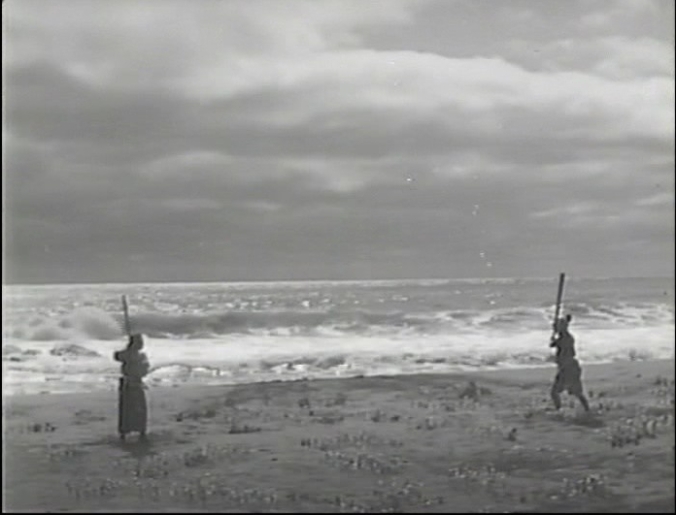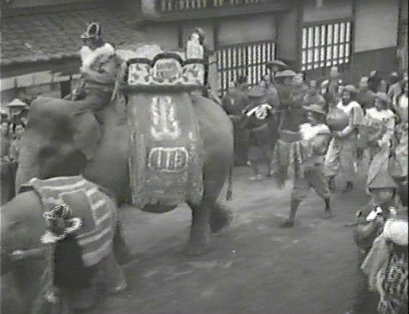
Duel at Ganryu
In spectacular fashion, Kojiro Sasaki marks the return of both Hideo Inagaki and the Japanese film industry to chanbara after a five year hiatus during the Occupation. It also marks the first post-war appearance of the Musashi Miyamoto story, which became one of the fundamental stories of Japanese cinema into the present day, with the duel of Miyamoto and Sasaki holding for Japanese audiences something like the fascination that the OK Corral legend holds in American Westerns.
The historical Miyamoto was a great swordsman in the years after Sekigahara, at least according to his own writings, and had long been celebrated. The modern view of him really started with the 1935 serial novel by Eiji Yoshikawa, which emphasized his transformation from a talented wild man into a disciplined master through spiritual self-awareness, a transformation depicted in most post-war film presentations. The best-known of these in America is Inagaki’s own Samurai Saga trilogy (available from Criterion), which like most others culminates in the duel at Ganryu Island with Kojiro Sasaki, regarded historically as the only plausible equal of Miyamoto.
This movie, however, concentrates on Sasaki, and Miyamoto makes only one brief appearance before the final duel. It too finds its source in a novel, but a different one by Genzo Murakami in 1949-50 that fictionalized Sasaki’s career.
The jidai-geki in general and chanbara in particular had been strongly discouraged if not formally banned during the early years of the Occupation because of their associations with samurai militarism, and limited budgets of the time would have added a further layer of obstacles. Inagaki had been one of the pre-war giants in these fields, as we can see in Masamune Date, and had been essentially unemployable until the late 40s, when the Americans became more concerned about communists than Japanese militarists, though he returned by first directing a number of movies about children. By 1950, the political and the financial climate had changed enough that Inagaki could go back to what he had done best in the past.
When I said it was a spectacular return, I meant that in both a literal and an artistic sense. Toho Studio obviously threw a lot of money at this and we see a cast if not of thousands then at least of many hundreds. Extras crowd the street scenes and there are several courtly dance performances with large audiences. We even have a parade of the Portuguese and Dutch traders complete with elephant and camel. There are no full-scale battles, but Sasaki has a full complement of fights against large groups as well as individual swordfights. My DVD was a bit murky in the night scenes, but there is enough left to indicate that with a serious restoration this would be very impressive visually. Rashomon, released a few months earlier, is the earliest post-war jidai-geki I have come across, but it is a chamber play with basically two sets and four characters, while this is a 1950s epic in approach, with numerous characters and locations.
We even have a parade of the Portuguese and Dutch traders complete with elephant and camel. There are no full-scale battles, but Sasaki has a full complement of fights against large groups as well as individual swordfights. My DVD was a bit murky in the night scenes, but there is enough left to indicate that with a serious restoration this would be very impressive visually. Rashomon, released a few months earlier, is the earliest post-war jidai-geki I have come across, but it is a chamber play with basically two sets and four characters, while this is a 1950s epic in approach, with numerous characters and locations.
The spectacle never overwhelms and never seems to be the excuse for the movie. Everything is handled with skill and aplomb by Inagaki and his team, and the final twenty minutes on Ganryu Island is a superb demonstration of direction and editing to build suspense and drama for an ending everyone in the original audience already knew.
Despite a number of sword fights, the movie seems genuinely interested in building a rounded character for Sasaki, so we have less focus on his sword training than on his private life. This, to no one’s surprise, involves three women: his first love, a beautiful dancer, and most exotically, a Chinese princess from Okinawa played by Hideko Takamine.
She also seems to know kung-fu, since she tells Sasaki she “can put my fist through your chest,” but we do not see her demonstrate this particular skill. Rather than passionate romance, however, the women provide a way for us to see his ambition to become a well-rounded, educated and sophisticated man, including an unusual desire to see the world.
Nevertheless, the movie provides the template on which most post-war chanbara movies will be based —
the fight on the bridge, the fight in the clearing, the fight in the town street, the night fight in the woods, and of course the ultimate face-off of the two best swordsmen are all introduced (or reintroduced since we have so few surviving examples of the pre-war genre from which to judge) in the film, as well as the wandering swordsman out to improve his skills and the (usually three) women who fall in love with him along his travels.
Naturally, for most viewers, the first attraction is Toshiro Mifune as Miyamoto, and he is a powerful presence in only two scenes and perhaps no more than four lines (although given equal billing).
This is especially striking because the casting precedes Mifune’s more famous three-movie portrayal of Miyamoto by several years. Sasaki is played by Tomoemon Otani, whose film career covered only about five years. This seems to have actually been Nakamura Jakuemon IV, who assumed the stage name of Tomoemon Otani VII only a few years earlier and who lived to be proclaimed a Living National Treasure for his long career playing female roles in Kabuki. As with many other Kabuki stars in films, there is no hint of over-acting or mannered performance, and the sword scenes certainly make his specialty as women come as something of a surprise.
I first saw this after a surfeit of the great post-Yojimbo sixties wide-screen chanbara, so it initially seemed a bit tame, especially in its swordplay and its somewhat faded print. But once I saw a number of other movies of the immediate post-war years, it grew both in my estimation and in its significance. In many ways it may have been the most significant film of its date. Rashomon was sui generis, Till We Meet Again culminated the long cultural shift toward a more European approach to romance in movies, but Kojiro Sasaki opened up, or perhaps reopened, the most long-lasting and successful (and perhaps quintessential) of all the Japanese film genres.
My DVD version is subtitled as “the whole story,” apparently indicating that it is an amalgamation of Sasaki Kojiro released late in 1950, Zoku Sasaki Kojiro, and Ganryu-jima ketto, both in 1951. Running about 2:20, it would thus seem to be missing quite a bit of the trilogy. This may also help explain how the Kinema Junpo critics missed it — the three parts coming in two different years reduced its memorability and perhaps also lessened its dramatic impact.
At any rate, this is another significant work from 1950 that helped revitalize not only the popularity but also the artistic standards of the Japanese film industry. It had so many followers and imitations that it seems familiar, but nevertheless it is well worth seeing on its own merits.







Pingback: Sword for Hire / Vagabonds in a Country at War / Sengoku burai (1952) | Japanonfilm
Pingback: Samurai I / Musashi Miyamoto (1954) | Japanonfilm
Pingback: Two Musashis / Futari no musashi (1960) | Japanonfilm
Pingback: Kojiro’s Turning Swallow Cut (1961) | Japanonfilm
Pingback: Five Men of Edo / Edo gonin otoko (1951) | Japanonfilm
Pingback: Kojiro / Sasaki Kojiro (1967) | Japanonfilm
Pingback: Toshiro Mifune | Japanonfilm
Pingback: Musashi Miyamoto (1944) | Japanonfilm
Pingback: Gojoe / Gojo reisenki: Gojoe (2000) | Japanonfilm